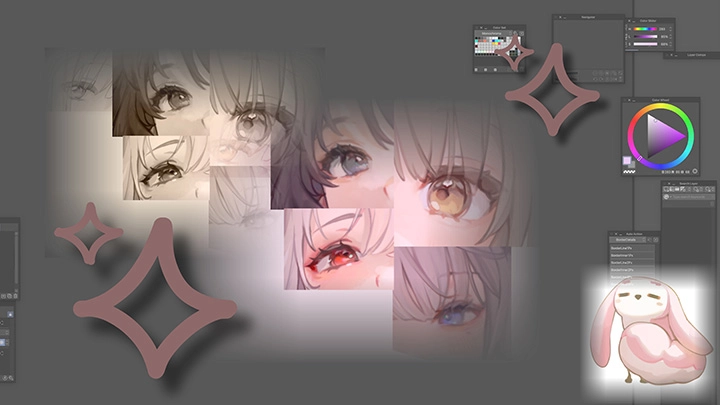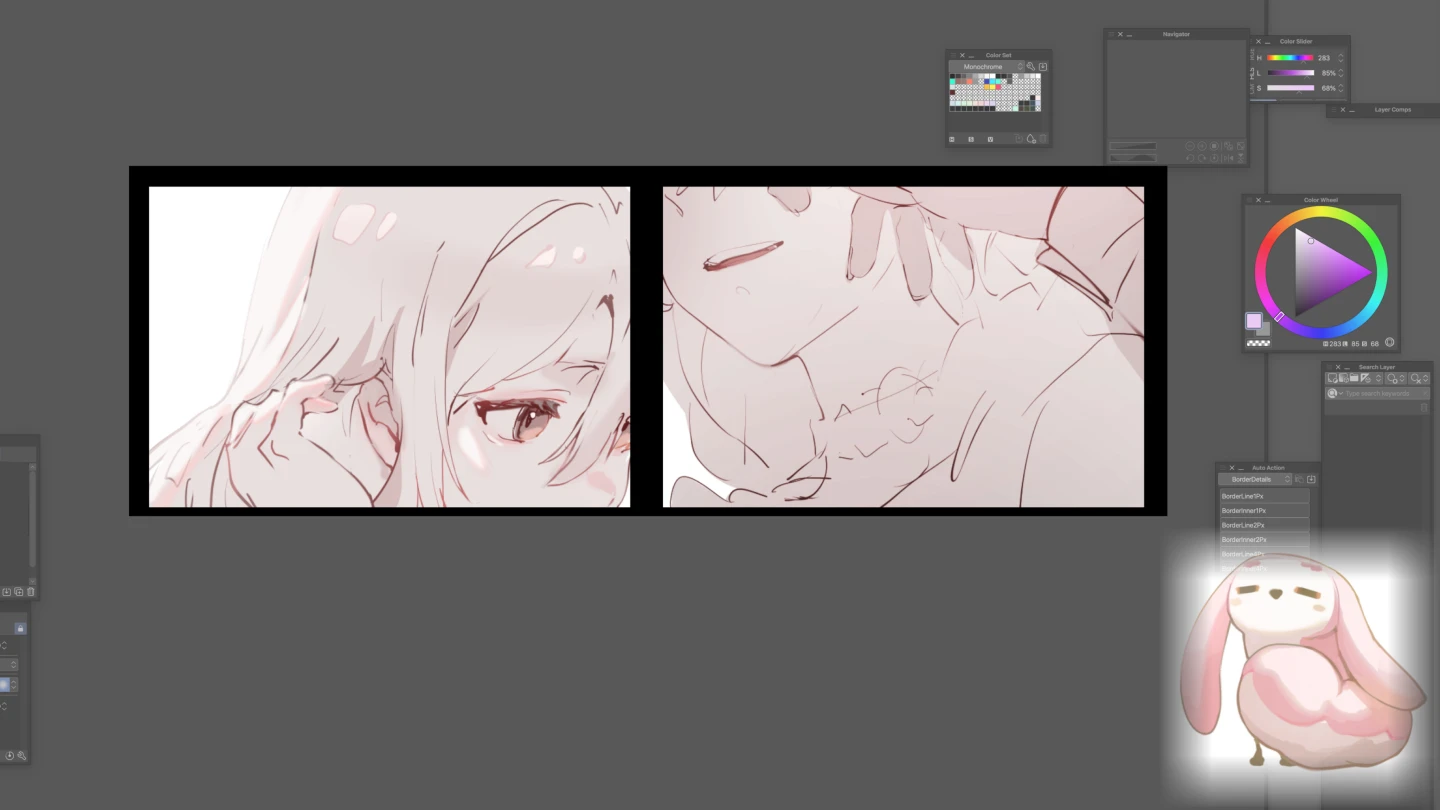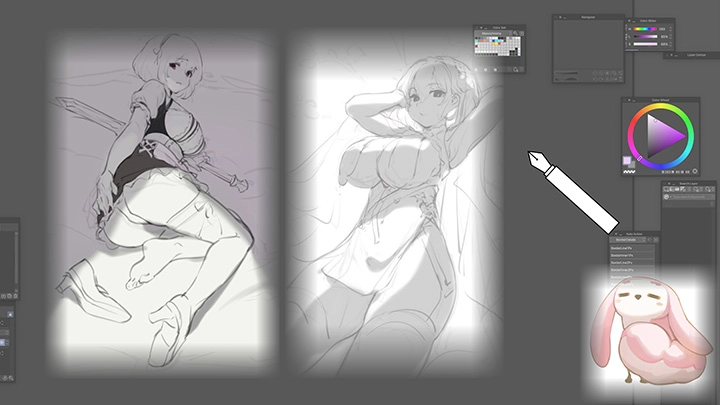Illustrator,Bibimbub Details
- Section 01
About the Course
01. Course Orientation- Course objectives overview - Basic mind mapping introduction to objective overview of the course
- Section 02
Introduction to Character Design Development
02. Customizing Work Interface and Basic Tools- Imported and step-by-step setting up workspace material - Imported and step-by-step setting up basic brushes for your comfort - Making use of stabilization options - Personalizing basic tools to shortcut settings
03. Approaching the Basic Proportions of Anatomy with Silhouettes- Explore body silhouettes in different angles with more tools to the keybinds - Taking a look at light/darken blending modes for loose lines to inside shapes - Stylizing general body shapes (liquify tool for body shape adjustment)
04. Approaching the Basic Proportions of Anatomy with Silhouettes: More Complex Shapes- Complex shapes for making hands and feet - Adding more objects to the body shape draft with hair, clothes, and accessories - Placing facial features on the head shape that correspond to the types of appearance characteristics
05. Making Use of Basic Composition- Examining basic principles of layout composition and balance - Build meaningful compositions with basic shapes and organic forms - Making use of the shapes of existing silhouettes & customizing with composition elements
- Section 03
Visual Cue Exploration: Building Your Own Style Preferences
06. Making a Safe Surface Evaluation of Colors- Introducing gradient map adjustments layers and setting shortcuts - Side comparison to 'gradient stripe template' for further multi-layered gradient map integration - Demonstration of different eyedropper tools to open an option for editing under adjustment layers
07. Adding Colors to the Character- Duplicating the artwork as a process checkpoint before proceeding (color sketch process) - Ways to glaze colors over the design to capture the right color in your mind with overlapping layers - Shortcuts setting to color/linear light blending mode
08. Exploring How a Subtle Color Shift to Opposite Side Color Is Pleasing to the Eye- Shortcuts setting to divide/different blending mode - Select color combinations for highlights and shadows to achieve the desired result
09. Personalized Contrast Preferences When Your Character Is Placed in Different Lightings- Adjusting the brightness of your design in different types of background lighting
- Section 04
Exploring Color, Lighting, and Edge Cues for Character Refinements and Rendering
10. Settling In with Your Preferred Lighting- About the tone curve adjustment layer - Introducing shortcuts to grayscale evaluation
11. Object Layers Manipulation and Restoration- Utilizing layer border filter to remove unwanted blurred edges/dust from object layers after layer separations for further refinement - Quick fix tip to revert position for accidentally moving the already satisfied layer without losing your progress to undoing
12. Soft Ambient Approach to Hard Light Approach- Specific method for blocking out depth from the design - Enhance the design and depth visibility by cutting edge contrast before manual adjustments
13. Go-to Rendering Process to the Character Design- Facial features & makeup - Hair - Nails and pedicure
14. More Go-to Rendering Process- Cloth ruffles - Texture rendering samples (checkered, jeans and laced/transparent clothing by making use of compare density & replace alpha blending mode)
- Section 05
Simplicity in Design: Chibi Stylization
15. Proportion and Body Structure of a Chibi- Let's step back and unwind after the intense rendering process! - Explore the adorable small proportions!
16. Simplify Details for Cute Decor Purposes- Focusing on edge cues to create simple shapes - Simplified head and face structure - Simplify and thicken hair locks
17. More Simplify Details for Cute Decor Purposes- Preparing for the next intense rendering process - Simplified further props and clothes details on the chibi
18. Making Use of Vivid Colors Glazing- Explore the overlay blend mode to add vibrancy to the eye with your self-selected, eye-catching colors - Introduction and guide of specific adjustment layer, limiting the amount of displayed colors and giving a pop-up look
19. Making Use of Lighting Glazing- Hard light blending modes to add volume to the chibi piece - Check for border dust before adding to the upcoming character sheet
- Section 06
Integration of Design Components: Character Sheet Development
20. Pinpoint Edges to Side View and Back View- Utilizing edge cues to identify lines/edges within the side view & back view - Understanding the relationship between the front view and the different viewpoint detail
21. Refining Side View and Back View- Continue rendering to finish - Step-by-step auto action to make selective visible merged layers - Making sure the image focuses lines on object edges
22. Rendering Layering Clothes and Props- Utilizing background blending mode to fill in obscured areas while maintaining surrounding details - Refining the character sheet and arrangement of the details
23. Guide to Making Attractive Changes to Facial Expressions- Exploration of possibilities of making minor expression changes to help convey emotions - Considerations for making significant changes to expressions (ex.open mouth and closed eyes)
- Section 07
Post-processing and the Final Touch
24. A Way to Touch up the Crispness- Step-by-step auto action for final touch-up - Manual customization to enhance work
25. Adding More Volume to Desired Specific Parts- Demonstrate adding colorful touches to the finishing pieces - Utilizing overlapping adjustment layers with layer blending mode
26. Making Variation Guides- Changing a white-based render color to a black-based
27. Challenging Making Variation Guides- Practice changing black-based colors back to the color of the original design
28. Overcoming Stack of Overlapping Adjustments Layers- Problems after piling up layer masks and adjustments of layers - Managing & merging, then applying to visible layers - Utilizing layer masks, selection, and fill - Step-by-step auto action to optimize the procedure
- Section 08
End Notes
29. Bonus Tips for Dealing with Early Mistakes- Retrieving line art drafts on the same layers with color line drafts & lower opacity/brighter line drafts - Making use of recently learned shortcuts to fix issues as they arise
30. Preparing for Another Art Endeavor- Auto action to start a new illustration - Summary of shortcuts used throughout the course - Farewell & good luck wishes







